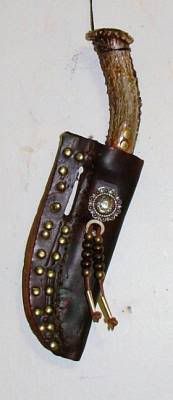While some were bent over the majority of originals from all periods I've seen (several hundred peices at least) by far were trimmed off and peened over.
To do it properly it is best/easiest to have a piece of brass flatstock say 2-3" wide by 3/4-1" thick by at least 8" long (the wider and longer the better) to use as an anvil, a double thick piece of the rubber poundo board or similar, a light weight ball pein hammer, and a pair of end cutters ground so that the face is flat.
Lay out your pattern - I just sketch the lines in with either a red mini ball pen or a soft lead pencil. For spacing I put in a few of the major points and then eye ball to fill in the pattern.
Once the pattern is layed out use a leather awl to start the hole - BTW the leather needs to be a GOOD grade of veg tan and although I have used thinner I recommend it be least harness weight, 8/10 or 10/12 oz with a nice tight grain. Drive in three of four tacks at a time and then turn the piece over with the heads on your brass "anvil" - the anvil should be mounted on a heavy piece of wood or layed over a nice firm piece of poundo board. This cuts down on noise and also keeps it in place. Take your end cutters and clip the shank off flush with the surface of the leather. Then using the flat face of the hammer tap LIGHTLY on the shank until you flatten out the center ridge left by the cutters. Then using the ball end tap a few times to flare the end of the shank and drive it slightly below the surface. Run your hand over the piece and make sure the shank is not poking out. Turn the piece over and make sure the tack heads feel solid - no matter how careful you are some shanks will want to bend side wise - if they do yank em out and do it over. Still no matter what over time and with much uses some tacks will pop out - most original pieces are missing a few tacks here and there so it just makes the piece more authentic!
This sounds more complicated than it is and it goes pretty fast once you get the rhythm - but on the belts there can be between 400-600 tacks depending on the size so no matter what it is time consuming.
Personally I am starting to use the solid brass tacks for this type, not only is more historically documented for this type work, from what info I have garnered steel shank tacks weren't used until some time around 1870 or so, and even after that the solid brass was the most used. They are expensive but well worth the extra cost.
Also lost tacks are common on tacked leather goods, see the original in the first pic on the left, which, to me, implies that they were not normally bent/clinched (pulling a clinched tack out usually tears the crap out of the leather). In most cases the sheaths I examined were also glued using some form of hide glue.
Again in my experience when using tacks the leather needs to be good and firm - soft leather just doesn't cut it . The solid brass square shank tacks are also much grippier than the smooth steel ones.
Here's an original using solid brass (shank and head) square shank tacks, - (they are still available from
www.thetrunkshoppe.com - not cheap but the only source I've been able to find for them and for the so inclined the only historically documented tack for pre-1870 usage):
And here's one of mine - an 1870's model - using the commonly available steel shank/solid brass head tacks (which historically can be dated to the early 1870's and later)
and here's the front side........
Notes on Usage: In general terms brass tacks were used sparingly pre-1850 (as compared to the later periods when they often literally covered belts and other gear). Therefore the cost isn't as critical if one chooses to use the cast/square shank tacks.
Steel vs brass shanks: The best data I have is that steel shank tacks didn't appear until the 1870's - see the 1878 note above and a steel shank tack was found at Adobe Walls, TX with a date of 1874.
Currently the ONLY supplier of solid cast brass (actually bronze), square shank tacks is the Trunk Shoppe
www.thetrunkshoppe.com. They are not cheap - starting price is $0.45 each - but they are well worth it when one wants to be historically correct to the nth degree. A word of caution: the cast tacks are SOFT - so one must pre-drill (I use an awl and punch a hole). The rough square shanks hold very well.
On the other hand the steel shank are much less expensive and are generally accepted at most events without raising eyebrows.









